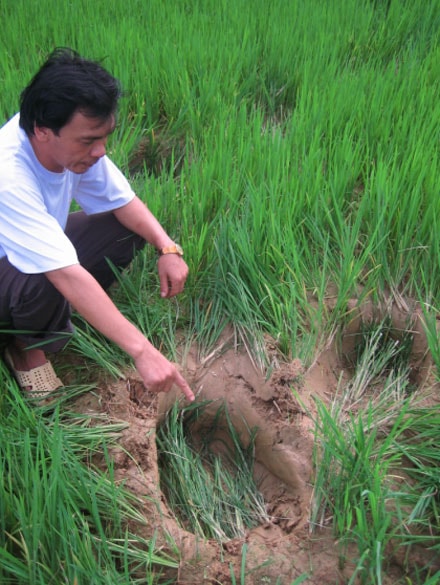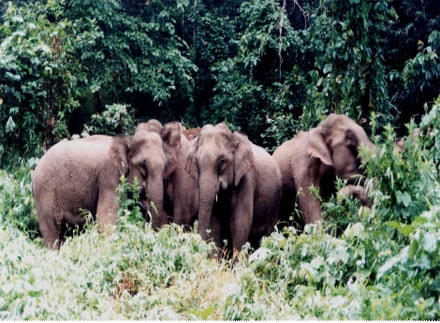Part 3: Pu Mat wild elephants and conservation solutions
(Baonghean) -Almost every year, wild elephants in Pu Mat go to the buffer zone of the National Park in Anh Son, Con Cuong, and Tuong Duong districts to find their favorite food, young bamboo shoots, and then destroy huts, fields, and crops, even injuring and killing some local people. And because of that, people discovered an elephant that had been murdered to take its tusks. The problem now is to quickly find a solution to protect the lives of people in the buffer zone, and to protect the very small number of wild Asian elephants in Pu Mat National Park.
When the wild elephant goes on a rampage
Back to the case of a local person being trampled to death by a wild elephant not long ago. On May 27, 2011, Mr. Vi Van Sinh (Luc Da-Con Cuong), a tree planter for Anh Son Forestry Company, was sleeping with three other people in a hut near the edge of the forest when a herd of wild elephants appeared. Hearing the noise, Mr. Sinh thought it was a buffalo and ran out to chase it away, but was trampled to death by the wild elephant, while the other three people escaped.
I went to Bai Lim, Anh Son district, where Nguyen Huu Than was trampled by an elephant, breaking his ribs and leg. Mr. Nguyen Cu recounted: Every time it is bamboo shoot season or rice season, elephants return, making the whole Bai Lim area lose sleep. Once, while sitting in the house, I saw a ferocious male elephant rushing out of the forest. It walked on a temporary bridge, breaking a wooden tree in half, and several people ran away. The elephant stopped in front of the hut, waving its trunk as if looking for salt, but when it smelled the smoke, it turned back. I thought that if it got angry, just one gore would destroy my house.

Elephant footprints in Bai Lim (Anh Son)
Mr. Tran Hoa in Khe Xan said: The wild elephants are very strange, they hate the sound of engines and iron and steel. The whole village has 3 rice mills, but they still have to carry rice to mill elsewhere because when they hear the engine start, they are agitated, they rush out of the forest regardless of day or night, trampling the rice fields, attacking buffalo and cows. People's motorbikes often have to turn off when they reach Phan Thuy slope.
We made our way to Khe Kem waterfall (core zone of Pu Mat National Park), Mr. Hoang Huu Son - Station Chief of Khe Kem Forest Management Station said: "The Khe Kem waterfall area has many bamboo, reed, and wild banana areas, so elephants often come out to forage. Almost every night, elephants stand in front of the station's volleyball court, and they do not cause any damage. However, elephants "hate" flashy colors and metal objects. The system of markers and signs on the road to Khe Kem waterfall that broke down were all due to elephants." Tourists visiting the foot of Khe Kem waterfall must leave their cars and motorbikes with someone to look after them, leaving them scattered along the road for fear of being trampled by elephants. As in the case of Mr. Vi Van Xao in Yen Khe, who went to the waterfall to play and left his car on the edge of the forest, it was trampled by elephants. To deal with wild elephants, many communes and villages have established militia and self-defense teams in conjunction with local people to organize guarding, lighting fires, beating gongs and drums during the wild elephant season. A resident of Bai Lim-Phuc Son confided: Chasing elephants like that is not safe, sometimes you could lose your life, who will be responsible? We hope the government will take measures to isolate wild elephants from the people so that people can feel secure in their production and business.
Early solution to save wild elephants
Asian elephants in Nghe An are currently distributed in 3 areas: Pu Mat National Park, Pu Huong and Pu Hoat Conservation Areas. Pu Mat National Park is estimated to have the largest number of elephants with 3 herds of 15 individuals.
The first herd has 5 individuals distributed in the Northwest in the communes of Tam Quang, Tam Dinh, around Pu Xam Liem, Khe Thoi, Khe Mat, Khe Van mountains. The second herd has 3 individuals concentrated in the center of the National Park including the communes of Chau Khe, Yen Khe and Luc Da, the elephant herd often operates in the forests of Khe Bu, Khe Choang, Khe Kem. The third herd has at least 7 elephants distributed in the Southeast in Phuc Son commune, the elephant herd often appears in the area of Bai Lim, Cao Veu... then moves to Thanh Chuong district.
Elephants in Pu Mat are Asian elephants (Elephas maximus) of the Proboscidea order, which usually live in secondary forests (mixed bamboo forests). Elephants live in herds and tend to develop into small groups according to family tradition, including father elephant, mother elephant and baby elephant. Elephants are considered intelligent animals with the ability to remember and take revenge when hunted or disturbed in their living areas. The elephants' active area is very large, moving to find food, water and salt. In the dry season when water and food are scarce, elephants can move over 30 km a day, over an area of about 4,000 hectares, during the day elephants avoid the sun in the forest near water sources. The elephants' food is also quite diverse, Pu Mat National Park has recorded 62 food species, including 51 forest tree species and 11 crop species.

Pu Mat wild elephant herd (photo: Pu Mat National Park)
The current problem is that the development of raw material forests and rubber forests has narrowed the habitat of elephants, especially in the buffer zone of Pu Mat National Park at Bai Lim (Cao Veu, Anh Son). This results in a lack of food sources and living space, so elephants often move to residential areas to find food and conflict with humans. In fact, elephants destroy crops and threaten people's lives with increasing seriousness. However, the coordination between the government and relevant departments to take measures to prevent conflicts between humans and elephants is still limited.
It is known that the Prime Minister has issued Decision No. 733/2006/QD-TTg "on approving the urgent action plan until 2010 to conserve elephants in Vietnam", focusing on building and implementing 3 long-term habitat conservation areas for elephants in Vietnam, including Nghe An, Dak Lak, Dak Nong and Dong Nai provinces, where the best number of elephants are currently located in terms of herd size, habitat, and living area.
Mr. Tran Xuan Cuong, Deputy Director of Pu Mat National Park, said: Up to now, the Elephant Conservation Project in Nghe An of Pu Mat National Park has not been implemented yet. The reason for the delay is: After the Prime Minister's Decision 733, the Provincial People's Committee assigned the National Park to develop an elephant conservation project, then submitted it to the Ministry of Agriculture and Rural Development for appraisal. The Ministry of Agriculture and Rural Development sought comments from the Ministry of Finance, Planning and Investment, Forest Protection Department... Then compiled and issued Official Dispatch No. 3318/BNN-KL dated November 29, 2007 "on comments on appraisal of the elephant conservation project in Nghe An." At the same time, it requested the Nghe An Provincial People's Committee to approve the project. The project was approved by the Provincial People's Committee in Decision No. 5250/QD-UBND dated November 26, 2008. The Provincial People's Committee assigned Pu Mat National Park to invite consulting units to prepare technical designs and estimates. After more than a year of announcing the selection of consultants, only one unit has accepted, however, the technical design and budget have not been approved. Pu Mat National Park has sent a document to the General Department of Forestry, Ministry of Agriculture and Rural Development asking for opinions on this matter, but so far there has been no response. While conservation activities have not been carried out, over the years there have been many serious conflicts between elephants and people, people were gored by elephants, broke their bones, lost their lives, and elephants were killed by people for their tusks. If the elephant conservation project had been urgently implemented in accordance with the spirit of Decision 733 of the Prime Minister, there would not have been such heartbreaking consequences.
In Vietnam, in the past 20 months, at least 10 elephants have been killed (including 1 in Nghe An). The number of Vietnamese elephants, both domesticated and wild, is facing the risk of extinction. Therefore, a quick solution is needed to save the endangered wild elephants.
Van Truong
